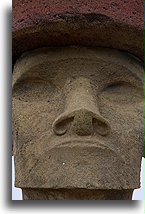


Located along the northeastern coast of Easter Island, Anakena beach is one of two sand beaches on the whole island. It is often cited as the landfall of the first Polynesians in the 9th century and location where the first European explores moored like Dutch Jacob Roggeveen who "discovered" this island or Englishman Captain James Cook in 18th century. Anakena is a place where there are two ahu (platforms), one noteworthy for the beauty of the satues. Ahu Nau Nau has seven moai (statues), four of them are decorated with pukao (topknot) made of red volcaninc rock. Statues have preserved facial details, shaped lips and beautiful long ears. Archeological discoveries from this site suggest that eyes were not empty, but filled with white coral and red volcanic irises.



For some reason one of the fallen moai has not been re-erected, even though it belongs to a platform next to Nau Nau It lays face up suggesting that it might not have been pushed down by people, but possibly by strong waves. Located further to the right is another small Ahu Ature Huki. It has a single standing moai that looks inland like all others.







